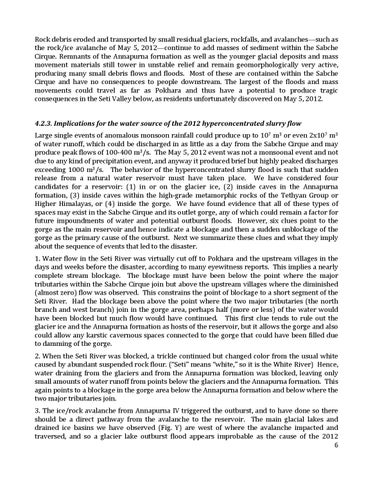Rock debris eroded and transported by small residual glaciers, rockfalls, and avalanches—such as the rock/ice avalanche of May 5, 2012—continue to add masses of sediment within the Sabche Cirque. Remnants of the Annapurna formation as well as the younger glacial deposits and mass movement materials still tower in unstable relief and remain geomorphologically very active, producing many small debris flows and floods. Most of these are contained within the Sabche Cirque and have no consequences to people downstream. The largest of the floods and mass movements could travel as far as Pokhara and thus have a potential to produce tragic consequences in the Seti Valley below, as residents unfortunately discovered on May 5, 2012. 4.2.3. Implications for the water source of the 2012 hyperconcentrated slurry flow Large single events of anomalous monsoon rainfall could produce up to 107 m3 or even 2x107 m3 of water runoff, which could be discharged in as little as a day from the Sabche Cirque and may produce peak flows of 100-‐400 m3/s. The May 5, 2012 event was not a monsoonal event and not due to any kind of precipitation event, and anyway it produced brief but highly peaked discharges exceeding 1000 m3/s. The behavior of the hyperconcentrated slurry flood is such that sudden release from a natural water reservoir must have taken place. We have considered four candidates for a reservoir: (1) in or on the glacier ice, (2) inside caves in the Annapurna formation, (3) inside caves within the high-‐grade metamorphic rocks of the Tethyan Group or Higher Himalayas, or (4) inside the gorge. We have found evidence that all of these types of spaces may exist in the Sabche Cirque and its outlet gorge, any of which could remain a factor for future impoundments of water and potential outburst floods. However, six clues point to the gorge as the main reservoir and hence indicate a blockage and then a sudden unblockage of the gorge as the primary cause of the outburst. Next we summarize these clues and what they imply about the sequence of events that led to the disaster. 1. Water flow in the Seti River was virtually cut off to Pokhara and the upstream villages in the days and weeks before the disaster, according to many eyewitness reports. This implies a nearly complete stream blockage. The blockage must have been below the point where the major tributaries within the Sabche Cirque join but above the upstream villages where the diminished (almost zero) flow was observed. This constrains the point of blockage to a short segment of the Seti River. Had the blockage been above the point where the two major tributaries (the north branch and west branch) join in the gorge area, perhaps half (more or less) of the water would have been blocked but much flow would have continued. This first clue tends to rule out the glacier ice and the Annapurna formation as hosts of the reservoir, but it allows the gorge and also could allow any karstic cavernous spaces connected to the gorge that could have been filled due to damming of the gorge. 2. When the Seti River was blocked, a trickle continued but changed color from the usual white caused by abundant suspended rock flour. (“Seti” means “white,” so it is the White River) Hence, water draining from the glaciers and from the Annapurna formation was blocked, leaving only small amounts of water runoff from points below the glaciers and the Annapurna formation. This again points to a blockage in the gorge area below the Annapurna formation and below where the two major tributaries join. 3. The ice/rock avalanche from Annapurna IV triggered the outburst, and to have done so there should be a direct pathway from the avalanche to the reservoir. The main glacial lakes and drained ice basins we have observed (Fig. Y) are west of where the avalanche impacted and traversed, and so a glacier lake outburst flood appears improbable as the cause of the 2012 6
Dhananjay Regmi: Causes and human impacts of the Seti River (Nepal) disaster of 2012

Issuu converts static files into: digital portfolios, online yearbooks, online catalogs, digital photo albums and more. Sign up and create your flipbook.